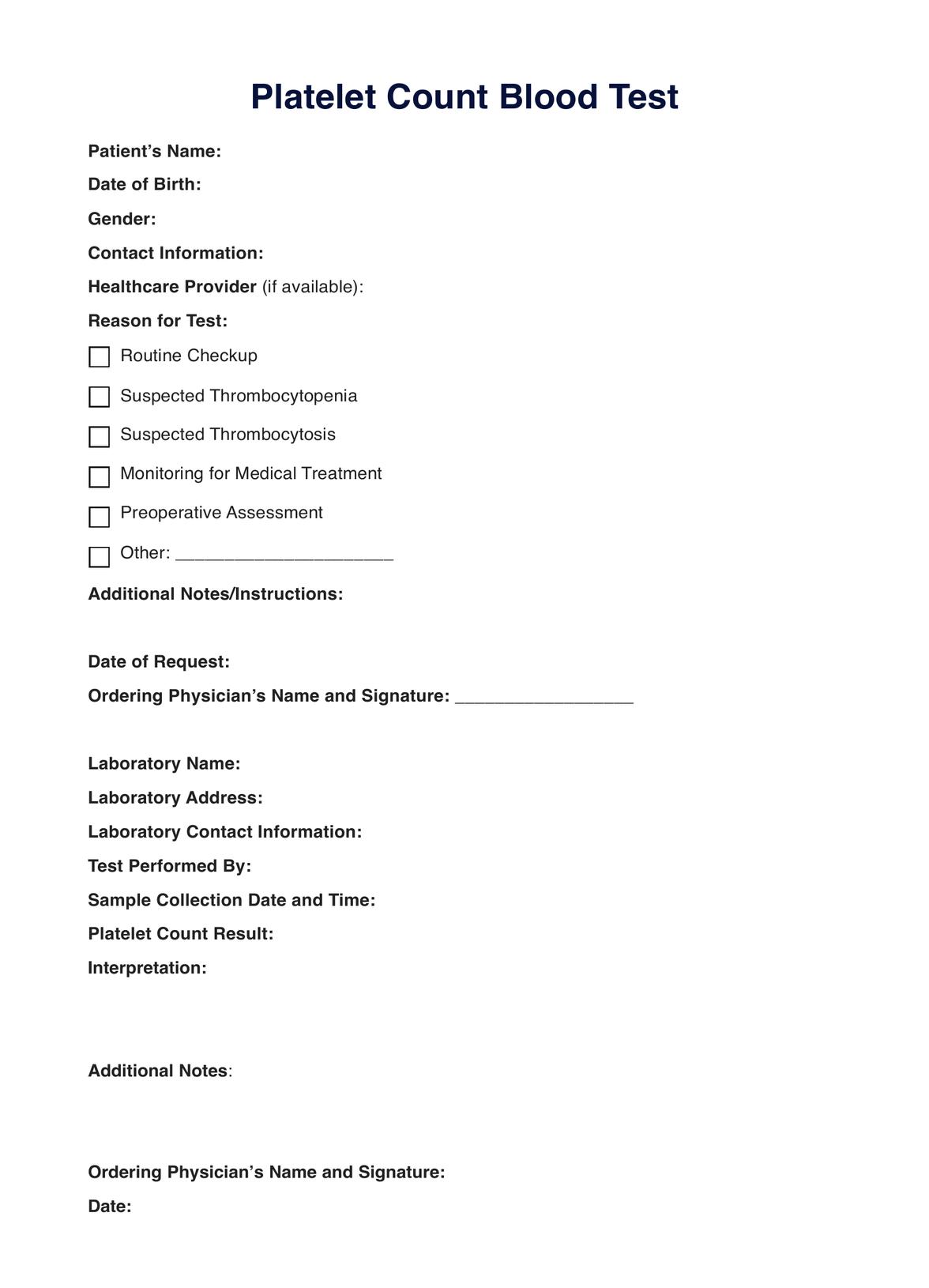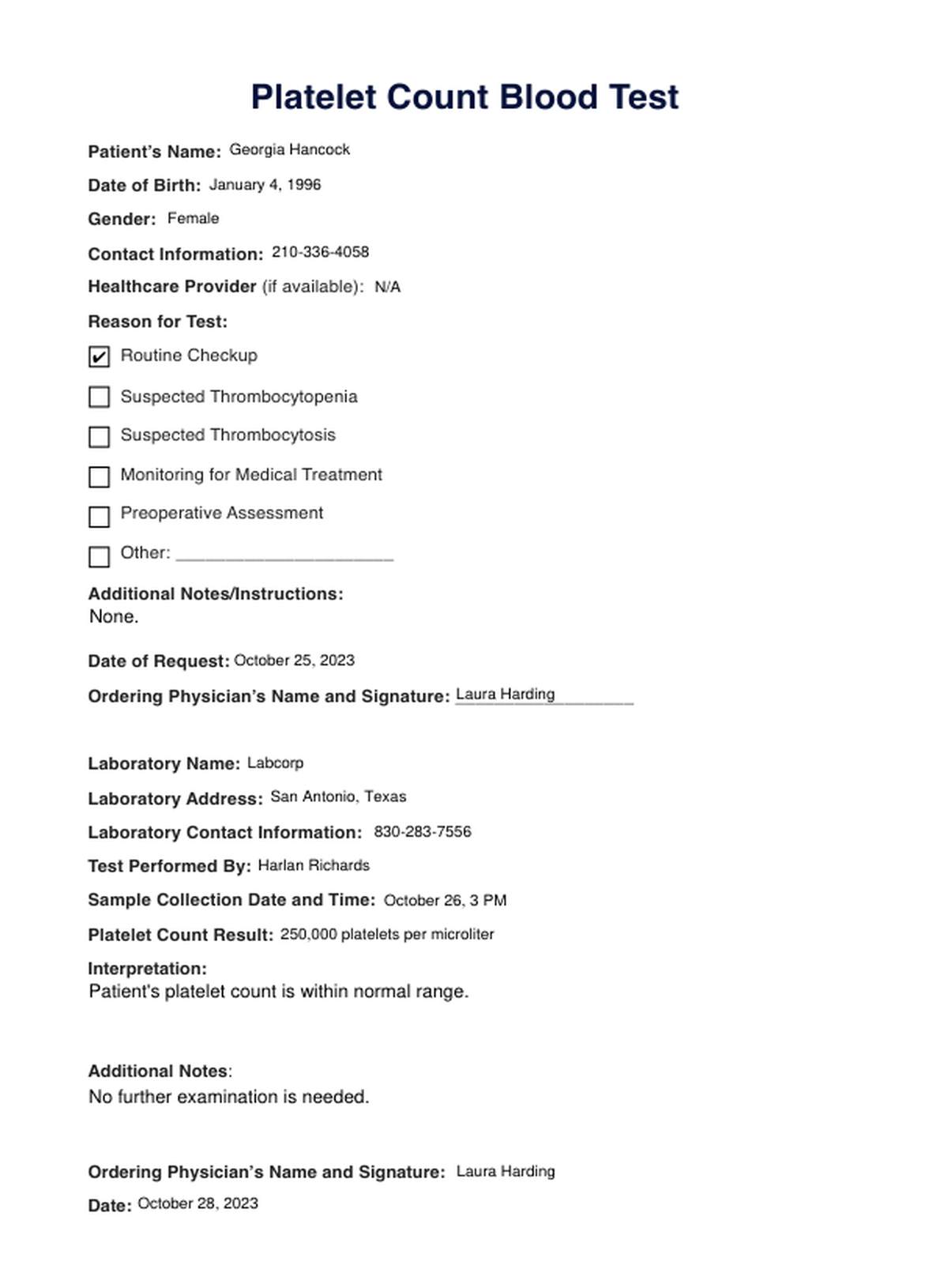Platelet Count Blood
Learn more about the value of the platelet count blood test, its uses, general result interpretations, and more with our comprehensive guide.


What is a Platelet Count Blood Test?
A platelet count blood test is a routine medical test designed to assess the quantity of platelets in an individual’s blood. This test is often included during a complete blood count test (CBC), a comprehensive analysis that checks the quantity of white blood cells, red blood cells, and platelets.
The platelet count blood test aims to diagnose and monitor conditions causing excessive bleeding or clotting within the body. Aside from that, the test also aids practitioners in identifying any platelet disorders, gauging a patient’s risk of bleeding, and tracking their progress during medical interventions that affect the blood, such as chemotherapy or blood-thinning therapies. There’s a need to measure the levels of platelets because elevated or diminished platelet counts are related to varying degrees of health risks.
The test’s procedure is similar to a routine blood screening. A blood sample will be collected if the referring physician suspects the patient has a deficiency or excess platelet count. Afterward, the sample will be processed by a laboratory, with results sent to the referring physician to be analyzed and interpreted.
It’s a given that request forms and documents where one can write down the analysis and interpretation of the platelet count blood test will differ from one practitioner to another. But if you don’t have one or want to switch yours out with a new one, you can check out our template of both that you can download and use in your practice. Keep reading below for a step-by-step on how to obtain a copy for yourself.
Platelet Count Blood Template
Platelet Count Blood Example
How does it work?
Step One. Grab a Copy of the Template
Obtain a digital and printable platelet count blood test template copy in cases of need by doing either of the steps below:
- Click the “Download Template” or “Use Template” button
- Search “Platelet Count Blood test” on Carepatron’s template library’s search bar on the website or app
Step Two. Create a Request
With our template, you can create a request in minutes, especially once you’ve determined that your patient needs the test based on your interview, analysis, or physical examination. Simply fill out the section designed as a request form with the essential information.
Step Three. Show the Form
As proof, you, your patient, or your fellow healthcare practitioner must show the request form you filled out to the phlebotomist. Only then will they collect and give the specimen to the laboratory to be processed.
Step Four. Analyze and Interpret
Depending on the laboratory, you may get the results within 24 hours or longer. But you can analyze and interpret the results as soon as possible. Ensure that you have a record of your observations and findings by writing them down on the second half of the template designed as a document for notes.
Step Five. Securely Store the Template
Whether you used the template section designed as a request form or document, it’s best to store the template securely. If you’re looking for a place to store digital copies, Carepatron is a HIPAA-compliant, free patient record software that can safeguard your patient’s records for easy retrieval.
When would you use this test?
There are a variety of clinical scenarios when a healthcare professional must gauge the number of platelets present in an individual’s blood. Here are some of them:
Routine Physical Examination
A platelet count blood test is often included in a comprehensive blood test, also known as a complete blood count (CBC). Therefore, a healthcare practitioner can request said test during a routine physical examination to ass a patient’s overall health and detect if they have any underlying blood-related problems.
Diagnose, Identify Causes, and Rule Out Other Conditions
Suppose the referring physician suspects that the patient has an abnormal platelet count, whether that’s thrombocytopenia (low platelet count) or thrombocytosis (high platelet count), based on their symptoms such as frequent nosebleeds, easy bruising, prolonged bleeding after getting injuries and recurrent bleeding. In that case, they may order a platelet count blood test to identify the underlying cause.
Aside from that, if the patient exhibits clinical manifestations of a platelet disorder, the referring physician may request a platelet count blood test to identify the patient's platelet-related conditions. They may also use the results to aid them in tailoring a treatment to manage the said condition better.
Preoperative Assessment
Before surgery, the referring physician requests a platelet count blood test to assess the patient’s risk of bleeding during the operations, especially if the procedure carries a high risk of significant bleeding. This information can help the surgeon and the physician in charge of post-operative care to make informed decisions during and after the surgery.
Monitoring
Patients undergoing medical treatments, specifically those on blood-thinning medications or chemotherapy, may undergo platelet count blood tests more often to monitor their risk of excessive bleeding or clotting. Monitoring one’s platelets also applies to patients with platelet disorders or related orders.
What do the results mean?
Healthcare practitioner gains valuable insights they can write down on their free platelet count blood test template from results from the test. And though it’s recommended that one analyzes and interprets considering a patient’s context, they need general interpretations of results; they can refer to the information below.
Normal Platelet Count
A patient’s level is considered normal if it falls between 150,000 and 400,000 platelets per microliter of blood.
Low Platelet Count
If the patient’s platelet count is below the lower threshold of 150,000 per microliter, they may be diagnosed with thrombocytopenia. If the patient has this condition, they have a high risk of bleeding. They may also experience easy bruising, excessive bleeding from minor cuts, heavy menstrual bleeding, muscle/joint pain, severe headaches, weakness, and dizziness.
If this is the case, it’s best to assess or investigate the factors contributing to the low count to manage it better. Some factors that may influence one’s platelet count are cancer treatments, certain types of cancer, heavy alcohol consumption, hemolytic uremic syndrome, immune thrombocytopenia, severe bleeding after an injury, and viral/bacterial infections.
High Platelet Count
On the other hand, if the patient’s platelet count exceeds the upper threshold of 450,000 platelets per microliter, this indicates thrombocytosis. This condition heightens the risk of blood clots, and the patient may experience symptoms of chest pain, thrombosis, weakness, dizziness, fatigue, and tingling and burning sensations in extremities with these conditions.
Similar to the condition wherein the patient has a low platelet count, it’s also best if one investigates which of the potential causes, like immune system issues, infections, problems of genes in charge of platelet production, and particular types of cancer, to intervene as soon as possible.
Remember, however, that the platelet count range may vary slightly depending on the specific laboratory conducting the test.
Research & Evidence
The utility of the platelet count blood test is well-supported by a body of research, articles, and studies highlighting its significance in diagnosing, monitoring, and even treating various medical conditions related to blood clotting and bleeding. Given that the platelet count blood test is well known in the medical community as an essential tool for the aforementioned purpose, we’ve decided to explore one study that supports using an alternative method and additional parameters for gathering platelet counts.
According to the “Study of platelet indices and their role in the evaluation of thrombocytopenia,” though a bone marrow examination is the gold standard when it comes to discriminating the causes of thrombocytopenia, an automated blood cell analyzer has made it possible to analyze platelet indices in a less expensive and invasive manner. Based on their findings, it is possible to assess thrombocytopenia with the following machine-derived parameters: mean platelet volume (MPV), platelet crit (PCT), and platelet distribution width (PDW).
Although we only provided an overview of a single study, multiple studies exist that talk about the value of measuring platelets and explore how to be more accurate when testing the count for more accurate diagnosis and monitoring. Therefore, we recommend updating yourself, especially when you use this test often.
References
- Saran, K., Vidya, K. R., Seema, K., Prasad, A., & Prakash, J. (2022). Study of platelet indices and their role in evaluation of thrombocytopenia. Journal of Family Medicine and Primary Care, 11(10), 6236. https://doi.org/10.4103/jfmpc.jfmpc_460_22
Commonly asked questions
General physicians and a specialist like a hematologist are the ones who can typically request a platelet count blood test.
You can use a platelet count blood test for multiple scenarios, such as a routine physical examination, diagnosis, preoperative assessment, and monitoring.
Though the collection will only take a few minutes, the results may take a few minutes or a few days, depending on the laboratory.











































































































